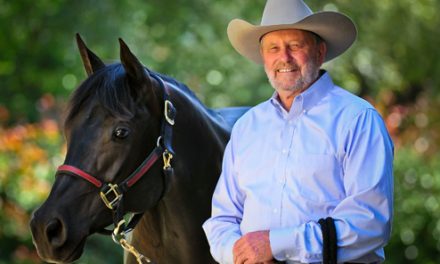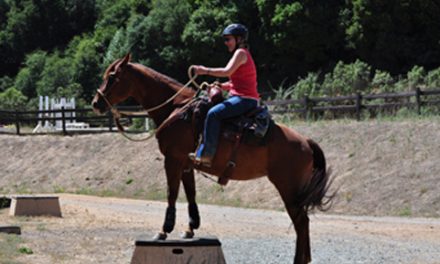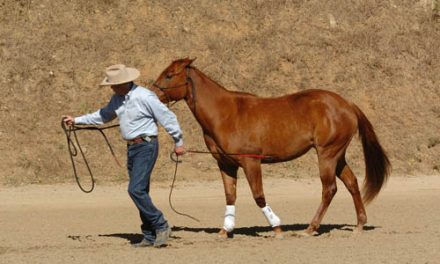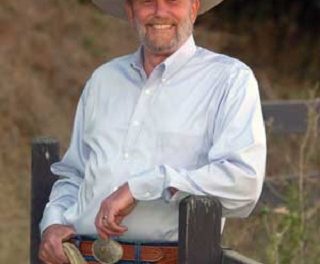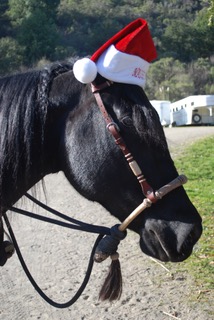
Any type of equipment that goes on a horse’s face but does not go into
the mouth is categorized as bitless. Thus, for example, the side pull is
categorized as bitless. One fellow has come out with a piece of
equipment called a bitless bridle. It is designed to make contact with the
chin and poll and it works quite well. I designed what I call the hack-a-
pull, a combination of a hackamore and a side pull. Riding a horse in a
cowboy or web halter is riding bitless. I ride many horses with
hackamores. A hackamore is made up of a bosal which is a firm piece
that goes around the nose and then the reins are attached under the chin.
There is a leather hanger that goes around the ears. When people ride
with a cowboy or web halter, the rope is tied similar to a hackamore.
For me, riding bitless is neither right nor wrong. Depending on the horse
and what you are trying to accomplish, the use of this type of equipment
may be very appropriate. I think someone that is just learning to ride
should use some type of bitless apparatus. A new rider usually does not
have good hands and I would rather the outside of a horse’s face be
pulled on rather than the mouth. A horse has sensitive areas on the edge
of the jaw and the nose and even a string halter can inflict pain. In
untrained hands, a regular hackamore can be very abrasive. I don’t
recommend starting a horse in training with a regular hackamore which
is usually 9/16 to 5/8 inch in diameter. What most horses are started with
is a large diameter hackamore. As training progresses, a smaller
diameter or pencil hackamore is used and then with a bridle.
All bitless apparatus will tend to rub under the horse’s chin. Getting
scuffed up is usual for a horse, in other words rubbed and sore. With
time, a horse will build up a callus and those areas will be less sensitive
but still feel. I have started colts in cowboy and regular halters, snaffle
bits and hackamores but if the hands aren’t trained, starting it in a halter
is better.
Each type of equipment has definite advantages. The most important
thing to remember is that it is not what you put on the horse’s face, it is
what you do with that piece of equipment. It comes down to your hands,
seat and legs. You must try to ride with an independent seat and not use
the reins for balance. Also, when you ask your horse to do something,
you must not ask with the reins while hanging onto them to remain
balanced. All that pulling would confuse the horse and the line of
communication would be lost.
Some horses, based on personality, can be pushy in the face. For that
type of horse, a piece of equipment, for instance a hackamore, with a
little more feel or weight to it is better. This will prevent the horse from
running through your hands. The skill of the rider and the personality of
the horse relate to the type of equipment that will work best.
A few years ago, I knew a fellow who did a lot of Parelli work and he
started his horse in a string halter. He did bareback riding with a halter
and he did a very nice job with the horse. However, as the horse got
more broke and the requests needed to be more specific, the feel of the
halter was too general. I found that out for myself when I was working
with a dressage trainer, Major Miguel Trevera. I wanted to see how
much I could accomplish using a hackamore. He told me it was not
specific enough to all the movements required for finished
horsemanship. A bit has more communication value. Stacy Westfall is
known for riding without a bridle but when she schools her horse she
uses a bridle. For some time, she rode the horse with just a rope around
its neck. It takes time to get a horse educated enough to understand that
type of communication. Also, her horse has a very docile personality. A
horse that is too smart or has a high flight instinct can be ridden without
a bridle but the horse must be sufficiently trained and predictable. A
compliant horse may be ridden without a bridle sooner than a willful
horse.
Depending on your goal, if you want to expand your horsemanship, you
will need to put a bit in the horse’s mouth. A request with a bit is more
specific and not as limited. I’ll talk more next time on riding with or
without a bit.
Charles Wilhelm

